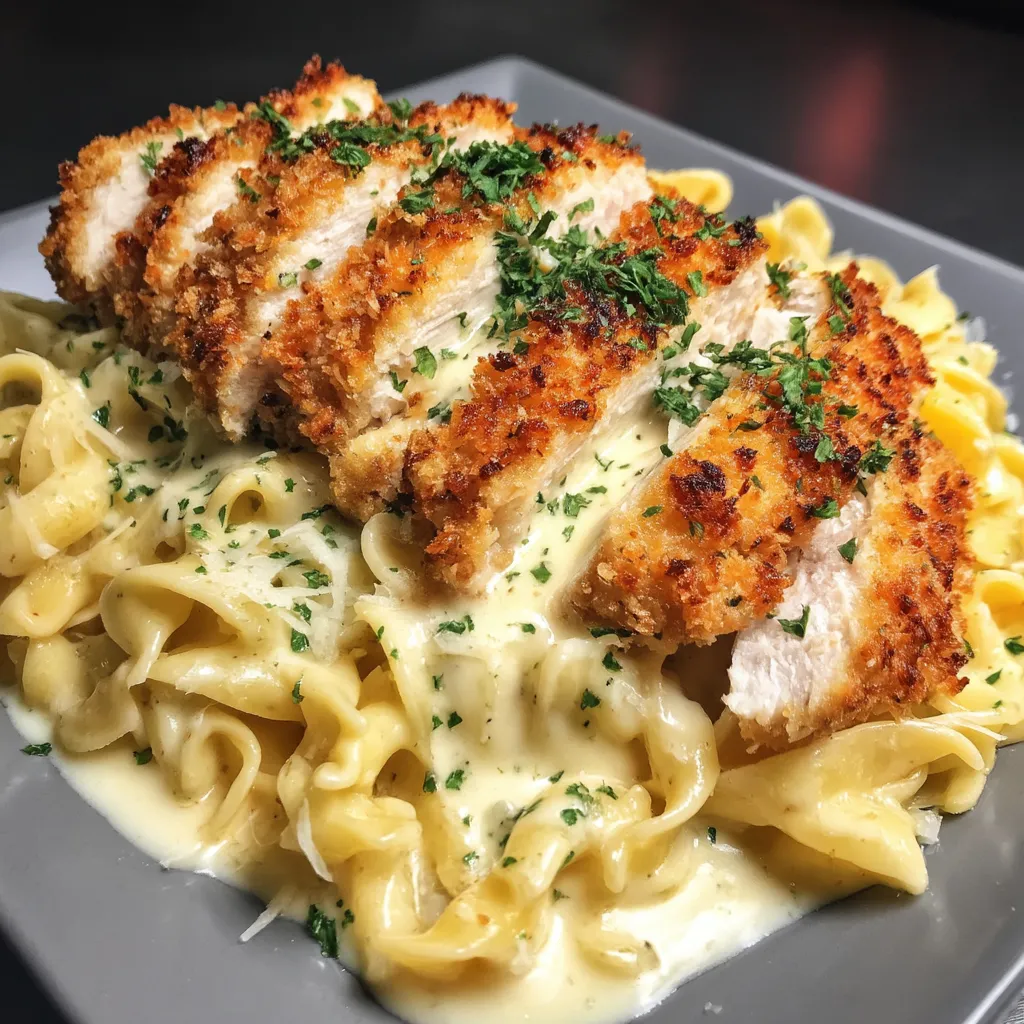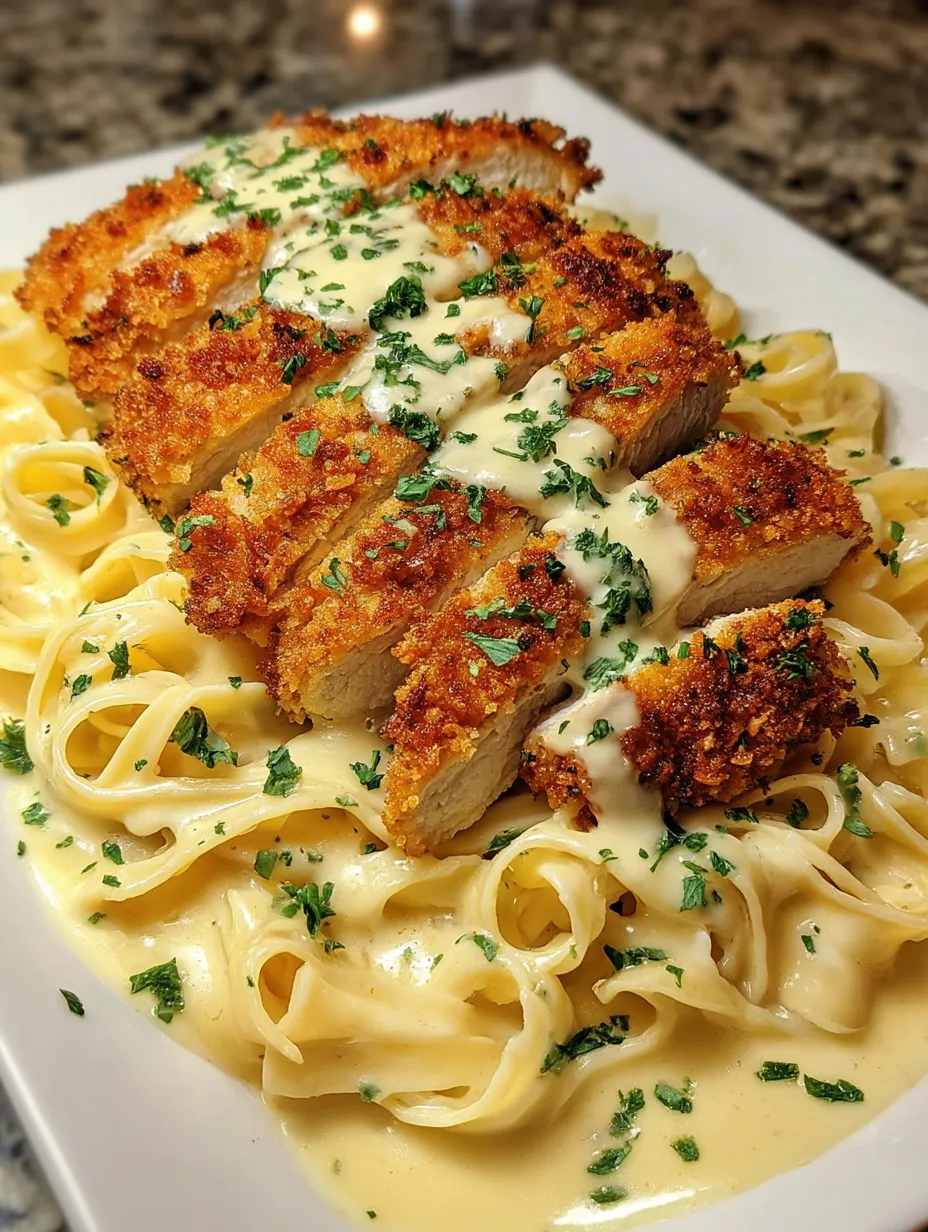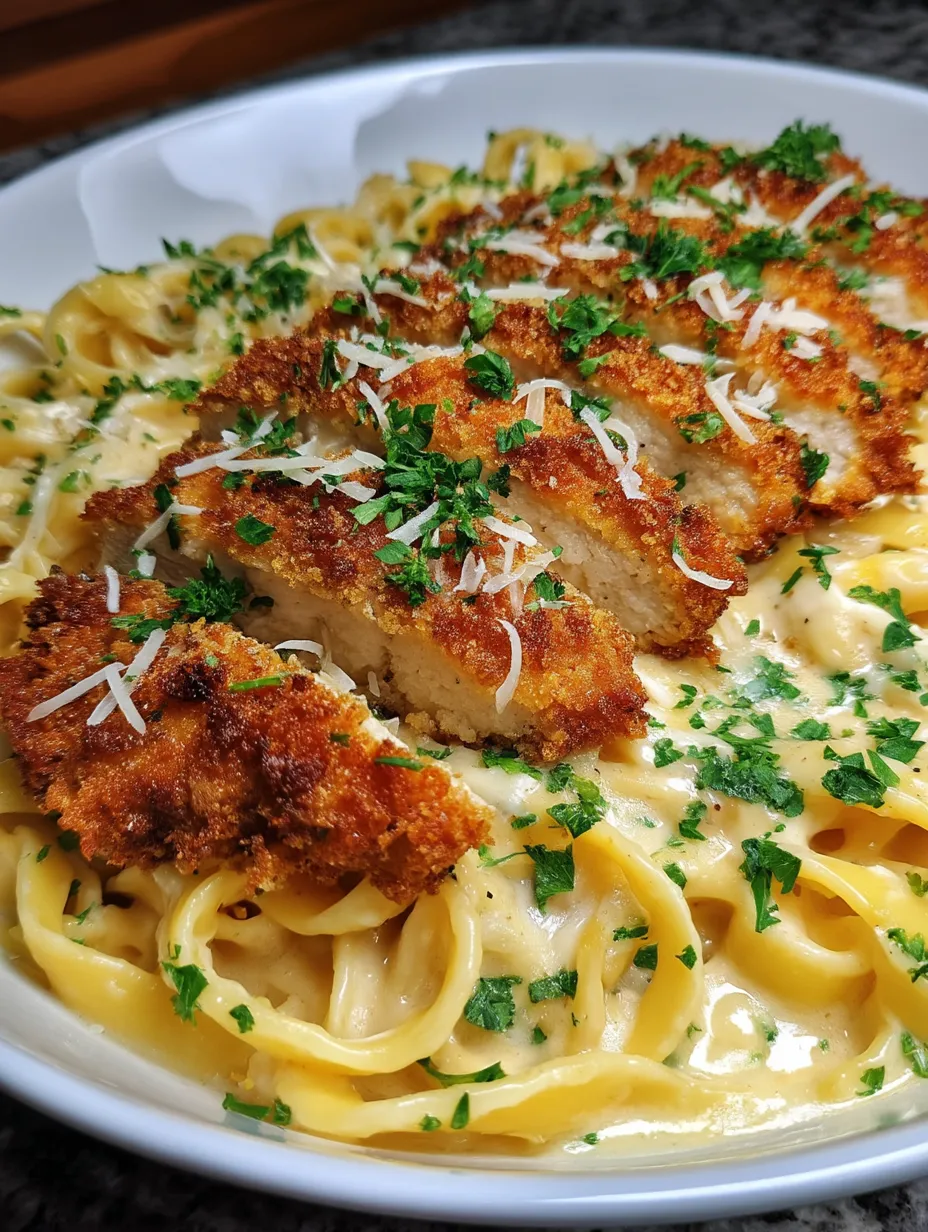 Pin it
Pin it
There's something magical about the combination of crispy, golden chicken on top of creamy, velvety pasta. This dish takes two comfort food favorites – breaded chicken cutlets and fettuccine alfredo – and combines them into one irresistible meal that looks impressive but doesn't require professional cooking skills. It's become my go to when I want to make something special without spending hours in the kitchen.
I first made this for my picky teenage nephew who normally just picks at his food. He demolished his entire plate then asked if there was more chicken. Now it's what he requests every time he visits. When a teenager gives you that kind of endorsement, you know you've got a winner on your hands.
Key Ingredients
- Thinly Sliced Chicken Breasts: The foundation that cooks quickly and evenly—if you can only find thick breasts, butterfly them yourself
- Panko Breadcrumbs: Creates that extra crispy coating that stays crunchy longer—worth seeking out instead of regular breadcrumbs
- Heavy Cream: Delivers that luscious, rich alfredo sauce—don't substitute half and half or milk if you want true alfredo texture
- Real Parmesan Cheese: Brings depth of flavor to both the chicken coating and the sauce—pre grated works but freshly grated melts better
- Pasta Water: The often overlooked secret ingredient that makes sauce silky rather than gloppy—don't forget to reserve some before draining
I discovered the magic of adding pasta water to alfredo sauce after watching an Italian chef demonstrate the technique. That starchy water helps the sauce cling to the pasta while keeping it loose enough to coat every strand perfectly. It's one of those small details that makes a noticeable difference in the final dish.
 Pin it
Pin it
Step-by-Step Instructions
- Breading Technique
- Setting up a proper breading station makes the process more efficient and less messy. The standard flour egg breadcrumb sequence exists for good reason—flour helps the egg adhere, egg helps the breadcrumbs stick, and breadcrumbs create that crispy exterior. Keeping one hand for dry ingredients and one for wet prevents the dreaded "breading fingers" that build up as you work.
- Pasta Perfection
- Cooking the pasta to al dente is crucial since it will continue cooking slightly when tossed with the hot sauce. That slight firmness provides textural contrast to the creamy sauce. Salting the pasta water generously flavors the pasta from within rather than relying solely on the sauce for flavor.
- Sauce Finesse
- Cooking the garlic briefly in butter before adding cream builds flavor without risk of burning. The constant whisking prevents the cream from separating while creating a smooth, emulsified sauce. Allowing the sauce to simmer for the full time thickens it naturally through reduction rather than through added thickeners.
- Chicken Cooking
- Maintaining proper oil temperature is key to perfectly crispy chicken—too hot and it burns before cooking through, too cool and it absorbs oil, becoming greasy. That golden color indicates proper doneness and maximum flavor development. Slicing after cooking and resting allows the juices to redistribute rather than running out.
- Final Assembly
- Tossing the pasta directly in the sauce coats each strand more evenly than pouring sauce on top. The additional pasta water loosens the sauce to the perfect consistency—it should coat the back of a spoon but still flow. Placing the sliced chicken on top rather than mixing it in preserves its crispy texture until serving time.
My first attempt at this dish was a disappointment because I drained the pasta and let it sit while finishing the sauce. By the time I served it, the fettuccine had clumped together into a solid mass. Now I time things so the pasta finishes just as the sauce is ready, allowing for immediate tossing while everything's hot.
Serving Suggestions
This hearty main course needs little accompaniment, but a few simple sides elevate the meal. A bright green salad with lemon vinaigrette provides acidic contrast to cut through the richness. Garlic bread makes an indulgent addition for sopping up extra sauce. For a lighter option, roasted asparagus or broccolini adds color and nutrition to the plate.
Creative Variations
Transform this basic recipe with simple swaps that create entirely new flavor experiences. Try pesto alfredo by stirring in a tablespoon of basil pesto to the finished sauce. Seafood lovers might appreciate substituting shrimp for chicken—just reduce cooking time accordingly. Add sliced mushrooms sautéed with the garlic for an earthy dimension. Spice enthusiasts can add red pepper flakes to the breadcrumb mixture for a kick of heat.
Storage Smarts
This dish is best enjoyed immediately when the contrast between crispy chicken and creamy pasta is at its peak. However, leftovers can be refrigerated for up to three days in airtight containers. For best reheating results, warm the pasta in a skillet with a splash of cream or milk to revitalize the sauce. Reheat chicken separately in a 350°F oven to restore some crispness rather than microwaving, which makes it soggy.
 Pin it
Pin it
I've been refining this recipe for years, gradually adjusting proportions and techniques. What started as an attempt to recreate a restaurant favorite has evolved into something that friends and family now specifically request. There's something deeply satisfying about mastering a dish that looks impressive but actually fits into a busy life—the perfect balance of special and doable that makes home cooking so rewarding.
Frequently Asked Questions
- → Can I bake the chicken instead of frying it?
- Yes, you can bake the breaded chicken for a lighter version! Preheat your oven to 425°F (220°C), place the breaded cutlets on a wire rack set over a baking sheet (this helps air circulate for crispier chicken), and bake for about 15-18 minutes, or until the internal temperature reaches 165°F (74°C). For extra crispiness, spray the breaded chicken with a little cooking oil before baking, and you can finish with a minute under the broiler for golden color.
- → How do I prevent my Alfredo sauce from breaking or becoming grainy?
- To keep your Alfredo sauce smooth and creamy, watch your heat carefully - it should never boil after adding the cheese. Simmer on medium-low heat and whisk constantly while adding the parmesan gradually, not all at once. Using freshly grated parmesan (never pre-grated) also helps prevent graininess. If your sauce does start to separate, a splash of pasta water and gentle whisking can help bring it back together. The starch in the pasta water acts as a natural emulsifier.
- → Can I make any parts of this recipe ahead of time?
- The chicken cutlets can be breaded up to 24 hours ahead and stored, covered, in the refrigerator. You can also fully cook the chicken, refrigerate it, and then reheat it in a 350°F (175°C) oven for 10 minutes to crisp it up again. However, the Alfredo sauce is best made fresh just before serving, as it can thicken significantly when cooled and reheated. If you must make it ahead, prepare it slightly thinner than desired, as it will thicken when reheated with a splash of cream.
- → What can I use instead of heavy cream for the Alfredo sauce?
- While heavy cream creates the richest texture, you can substitute half-and-half for a lighter version. For a non-dairy alternative, unsweetened cashew cream or full-fat coconut milk can work, though the flavor will be slightly different. Another option is to use whole milk mixed with 2 tablespoons of melted butter. Whatever substitute you use, you may need to simmer the sauce a bit longer to achieve the desired thickness, and the flavor won't be quite as rich as the original.
- → How do I ensure my chicken stays crispy when served with the pasta?
- For maximum crispiness, keep these tips in mind: 1) Make sure your oil is hot before adding the chicken (around 350°F/175°C is ideal). 2) Don't overcrowd the pan when frying - cook in batches if needed. 3) Place fried chicken on a wire rack instead of paper towels to prevent steaming. 4) Slice the chicken just before serving. 5) Most importantly, serve the chicken on top of the pasta rather than mixing it into the sauce, which would quickly soften the crispy coating.
